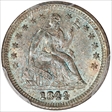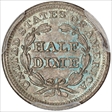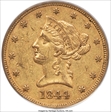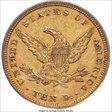Bahá’í History * 1844 * Birth of Bahá’í Faith 的钱币相册
*1844 - Beginning of Baha'i Faith with declaration of the Bab (the Gate) to Mulla Husayn in Shiraz, Persia on the night of May 22-23.
*1844 - Beginning of Baha'i Faith with declaration of the Bab (the Gate) to Mulla Husayn in Shiraz, Persia on the night of May 22-23.
*1844 - Beginning of Baha'i Faith with declaration of the Bab (the Gate) to Mulla Husayn in Shiraz, Persia on the night of May 22-23.
*1844 - Beginning of Baha'i Faith with declaration of the Bab (the Gate) to Mulla Husayn in Shiraz, Persia on the night of May 22-23.
1st purchase ever from famous Seated Liberty Dime expert Gerry Fortin, based in both Florida and Maine! His description: Little Orphan Annie Dime, Rare Grade, Steely Frosted Luster, EX Newtown Collection. This original 1844 Seated dime offering, via the Newtown Collection, was purchased from GFRC during 2016. 1844 dimes are well known for being hoarded in lower circulated grades and continue to be available. This date become rare at the AU grades with few arriving to market. This example provides pleasing bright light viewing with steely frosted luster and active cartwheels. Toning is a light gold probably consistent with a light dip prior to being encased. Strike is typical for the issue. PCGS has certified all of three pieces at the AU53 level with the last auction appearance dating back to 2009. (Only 14 graded higher 1/23) Housed in PCGS Gen 4.1 (2002-2004) holder.
1st purchase ever from famous Seated Liberty Dime expert Gerry Fortin, based in both Florida and Maine! His description: Little Orphan Annie Dime, Rare Grade, Steely Frosted Luster, EX Newtown Collection. This original 1844 Seated dime offering, via the Newtown Collection, was purchased from GFRC during 2016. 1844 dimes are well known for being hoarded in lower circulated grades and continue to be available. This date become rare at the AU grades with few arriving to market. This example provides pleasing bright light viewing with steely frosted luster and active cartwheels. Toning is a light gold probably consistent with a light dip prior to being encased. Strike is typical for the issue. PCGS has certified all of three pieces at the AU53 level with the last auction appearance dating back to 2009. (Only 14 graded higher 1/23) Housed in PCGS Gen 4.1 (2002-2004) holder.
1st purchase ever from famous Seated Liberty Dime expert Gerry Fortin, based in both Florida and Maine! His description: Little Orphan Annie Dime, Rare Grade, Steely Frosted Luster, EX Newtown Collection. This original 1844 Seated dime offering, via the Newtown Collection, was purchased from GFRC during 2016. 1844 dimes are well known for being hoarded in lower circulated grades and continue to be available. This date become rare at the AU grades with few arriving to market. This example provides pleasing bright light viewing with steely frosted luster and active cartwheels. Toning is a light gold probably consistent with a light dip prior to being encased. Strike is typical for the issue. PCGS has certified all of three pieces at the AU53 level with the last auction appearance dating back to 2009. (Only 14 graded higher 1/23) Housed in PCGS Gen 4.1 (2002-2004) holder.
EX Boylston Collection Die Pair 19, WB-105, Rarity-5, Large O. Far above average strike for this date in a New Orleans half, with especially crisp hair definition and complete eagle feathers. The 1844-O mintage was more than 2 million, yet it is a significant condition rarity in Mint State and is extremely difficult to locate above MS63. The date is lightly repunched and reverse shows interesting, identifying die lines. Scarce and desirable, only five MS64s at PCGS and five at NGC; only four coins grade higher. * * * * * * * * * * * * * * * * * * *
EX Boylston Collection Die Pair 19, WB-105, Rarity-5, Large O. Far above average strike for this date in a New Orleans half, with especially crisp hair definition and complete eagle feathers. The 1844-O mintage was more than 2 million, yet it is a significant condition rarity in Mint State and is extremely difficult to locate above MS63. The date is lightly repunched and reverse shows interesting, identifying die lines. Scarce and desirable, only five MS64s at PCGS and five at NGC; only four coins grade higher. * * * * * * * * * * * * * * * * * * *
EX Boylston Collection Die Pair 19, WB-105, Rarity-5, Large O. Far above average strike for this date in a New Orleans half, with especially crisp hair definition and complete eagle feathers. The 1844-O mintage was more than 2 million, yet it is a significant condition rarity in Mint State and is extremely difficult to locate above MS63. The date is lightly repunched and reverse shows interesting, identifying die lines. Scarce and desirable, only five MS64s at PCGS and five at NGC; only four coins grade higher. * * * * * * * * * * * * * * * * * * *
EX Boylston Collection Die Pair 19, WB-105, Rarity-5, Large O. Far above average strike for this date in a New Orleans half, with especially crisp hair definition and complete eagle feathers. The 1844-O mintage was more than 2 million, yet it is a significant condition rarity in Mint State and is extremely difficult to locate above MS63. The date is lightly repunched and reverse shows interesting, identifying die lines. Scarce and desirable, only five MS64s at PCGS and five at NGC; only four coins grade higher. * * * * * * * * * * * * * * * * * * *
EX Steve Studer Collection The 1844 $10 is one of the rarest No Motto Eagles from any mint; only 6,361 pieces defines a scarcity of survivors, and significantly, not a single 1844 Eagle was discovered among tens of thousands of gold coins in the S.S. Republic shipwreck. That low mintage begins to tell a story with good reasons for the rarity. After the Panic of 1837, the country went through some difficult years between 1838 and 1844. The unemployment rate was very high, and since there was virtually no social safety net in place, people actually starved in the USA. As a result, few gold coins were struck and even fewer were saved, therefore scattered abrasions and some marks on the portrait are not uncommon for the issue. Remember, the California Gold Rush had not yet occurred, and the issue was struck at a time when $10 was the highest gold denomination in the land. Only 40 to 50+ examples are presently known in all grades, When available, the typical 1844 ten dollar grades VF-XF, and AU coins are rare with perhaps only 10 pieces known. There are only two or three coins known in MS. Virtually all of the higher grade 1844 eagles that exist have come onto the market in the past few years. These have come from different sources, so it is unlikely that there was a hoard, and none appear to have originated overseas. Here is a well-detailed XF example of this early Philadelphia issue, showing original olive-gold patina. The auction record for Heritage June 2002 shows it sold for only $2,127.50 -- those were the days! -- and describes it thus: "The 1844 No Motto Ten is an exceptionally scarce coin with a low mintage of only 6,361 pieces, a mintage that, in this case, is a good indicator of how difficult the issue really is. Much luster is still in evidence beneath a uniform reddish patina and the most noticeable contact marks are found on Liberty's cheek and in the reverse field between the eagle's beak and the A in STATES." * * * * * * * * * * * * * * * * * * *
EX Steve Studer Collection The 1844 $10 is one of the rarest No Motto Eagles from any mint; only 6,361 pieces defines a scarcity of survivors, and significantly, not a single 1844 Eagle was discovered among tens of thousands of gold coins in the S.S. Republic shipwreck. That low mintage begins to tell a story with good reasons for the rarity. After the Panic of 1837, the country went through some difficult years between 1838 and 1844. The unemployment rate was very high, and since there was virtually no social safety net in place, people actually starved in the USA. As a result, few gold coins were struck and even fewer were saved, therefore scattered abrasions and some marks on the portrait are not uncommon for the issue. Remember, the California Gold Rush had not yet occurred, and the issue was struck at a time when $10 was the highest gold denomination in the land. Only 40 to 50+ examples are presently known in all grades, When available, the typical 1844 ten dollar grades VF-XF, and AU coins are rare with perhaps only 10 pieces known. There are only two or three coins known in MS. Virtually all of the higher grade 1844 eagles that exist have come onto the market in the past few years. These have come from different sources, so it is unlikely that there was a hoard, and none appear to have originated overseas. Here is a well-detailed XF example of this early Philadelphia issue, showing original olive-gold patina. The auction record for Heritage June 2002 shows it sold for only $2,127.50 -- those were the days! -- and describes it thus: "The 1844 No Motto Ten is an exceptionally scarce coin with a low mintage of only 6,361 pieces, a mintage that, in this case, is a good indicator of how difficult the issue really is. Much luster is still in evidence beneath a uniform reddish patina and the most noticeable contact marks are found on Liberty's cheek and in the reverse field between the eagle's beak and the A in STATES." * * * * * * * * * * * * * * * * * * *
EX Steve Studer Collection The 1844 $10 is one of the rarest No Motto Eagles from any mint; only 6,361 pieces defines a scarcity of survivors, and significantly, not a single 1844 Eagle was discovered among tens of thousands of gold coins in the S.S. Republic shipwreck. That low mintage begins to tell a story with good reasons for the rarity. After the Panic of 1837, the country went through some difficult years between 1838 and 1844. The unemployment rate was very high, and since there was virtually no social safety net in place, people actually starved in the USA. As a result, few gold coins were struck and even fewer were saved, therefore scattered abrasions and some marks on the portrait are not uncommon for the issue. Remember, the California Gold Rush had not yet occurred, and the issue was struck at a time when $10 was the highest gold denomination in the land. Only 40 to 50+ examples are presently known in all grades, When available, the typical 1844 ten dollar grades VF-XF, and AU coins are rare with perhaps only 10 pieces known. There are only two or three coins known in MS. Virtually all of the higher grade 1844 eagles that exist have come onto the market in the past few years. These have come from different sources, so it is unlikely that there was a hoard, and none appear to have originated overseas. Here is a well-detailed XF example of this early Philadelphia issue, showing original olive-gold patina. The auction record for Heritage June 2002 shows it sold for only $2,127.50 -- those were the days! -- and describes it thus: "The 1844 No Motto Ten is an exceptionally scarce coin with a low mintage of only 6,361 pieces, a mintage that, in this case, is a good indicator of how difficult the issue really is. Much luster is still in evidence beneath a uniform reddish patina and the most noticeable contact marks are found on Liberty's cheek and in the reverse field between the eagle's beak and the A in STATES." * * * * * * * * * * * * * * * * * * *
EX Steve Studer Collection The 1844 $10 is one of the rarest No Motto Eagles from any mint; only 6,361 pieces defines a scarcity of survivors, and significantly, not a single 1844 Eagle was discovered among tens of thousands of gold coins in the S.S. Republic shipwreck. That low mintage begins to tell a story with good reasons for the rarity. After the Panic of 1837, the country went through some difficult years between 1838 and 1844. The unemployment rate was very high, and since there was virtually no social safety net in place, people actually starved in the USA. As a result, few gold coins were struck and even fewer were saved, therefore scattered abrasions and some marks on the portrait are not uncommon for the issue. Remember, the California Gold Rush had not yet occurred, and the issue was struck at a time when $10 was the highest gold denomination in the land. Only 40 to 50+ examples are presently known in all grades, When available, the typical 1844 ten dollar grades VF-XF, and AU coins are rare with perhaps only 10 pieces known. There are only two or three coins known in MS. Virtually all of the higher grade 1844 eagles that exist have come onto the market in the past few years. These have come from different sources, so it is unlikely that there was a hoard, and none appear to have originated overseas. Here is a well-detailed XF example of this early Philadelphia issue, showing original olive-gold patina. The auction record for Heritage June 2002 shows it sold for only $2,127.50 -- those were the days! -- and describes it thus: "The 1844 No Motto Ten is an exceptionally scarce coin with a low mintage of only 6,361 pieces, a mintage that, in this case, is a good indicator of how difficult the issue really is. Much luster is still in evidence beneath a uniform reddish patina and the most noticeable contact marks are found on Liberty's cheek and in the reverse field between the eagle's beak and the A in STATES." * * * * * * * * * * * * * * * * * * *
May 22-23, 1844 * Declaration of the Báb The Báb's name in English means "the Gate". His appearance fulfilled prophecies of the Quran concerning the return of the Twelfth Imam, the Báb's 19-year Mission was to announce God's new message to humanity for this Day. Similar to John the Baptist as the return of Elijah and preparing the way for Christ, the Báb was to herald the arrival of One even greater than He, Who would fulfill the expected "return" of the prophets forecast in all the major world religions. This would be Bahá'u'lláh. >> The very next day after the Báb's proclamation of a new faith, Samuel Morse sent the very first telegraph (prophesied in the Bible, communication of "lightning speed" that would unite the East and West) -- Morse's first message, "What hath God wrought?" * * * * * * * * * * * * * * * * * * * www.bahai.org
May 22-23, 1844 * Declaration of the Báb The Báb's name in English means "the Gate". His appearance fulfilled prophecies of the Quran concerning the return of the Twelfth Imam, the Báb's 19-year Mission was to announce God's new message to humanity for this Day. Similar to John the Baptist as the return of Elijah and preparing the way for Christ, the Báb was to herald the arrival of One even greater than He, Who would fulfill the expected "return" of the prophets forecast in all the major world religions. This would be Bahá'u'lláh. >> The very next day after the Báb's proclamation of a new faith, Samuel Morse sent the very first telegraph (prophesied in the Bible, communication of "lightning speed" that would unite the East and West) -- Morse's first message, "What hath God wrought?" * * * * * * * * * * * * * * * * * * * www.bahai.org
May 22-23, 1844 * Declaration of the Báb The Báb's name in English means "the Gate". His appearance fulfilled prophecies of the Quran concerning the return of the Twelfth Imam, the Báb's 19-year Mission was to announce God's new message to humanity for this Day. Similar to John the Baptist as the return of Elijah and preparing the way for Christ, the Báb was to herald the arrival of One even greater than He, Who would fulfill the expected "return" of the prophets forecast in all the major world religions. This would be Bahá'u'lláh. >> The very next day after the Báb's proclamation of a new faith, Samuel Morse sent the very first telegraph (prophesied in the Bible, communication of "lightning speed" that would unite the East and West) -- Morse's first message, "What hath God wrought?" * * * * * * * * * * * * * * * * * * * www.bahai.org
May 22-23, 1844 * Declaration of the Báb The Báb's name in English means "the Gate". His appearance fulfilled prophecies of the Quran concerning the return of the Twelfth Imam, the Báb's 19-year Mission was to announce God's new message to humanity for this Day. Similar to John the Baptist as the return of Elijah and preparing the way for Christ, the Báb was to herald the arrival of One even greater than He, Who would fulfill the expected "return" of the prophets forecast in all the major world religions. This would be Bahá'u'lláh. >> The very next day after the Báb's proclamation of a new faith, Samuel Morse sent the very first telegraph (prophesied in the Bible, communication of "lightning speed" that would unite the East and West) -- Morse's first message, "What hath God wrought?" * * * * * * * * * * * * * * * * * * * www.bahai.org










































